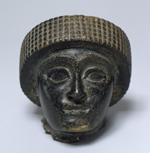Breath of Heaven, Breath of Earth: Ancient Near Eastern Art from American Collections
August 31 – December 22, 2013
Melvin Henderson-Rubio Gallery
A new exhibition, “Breath of Heaven, Breath of Earth: Ancient Near Eastern Art from American Collections,” showcases 64 remarkable objects that represent several thousand years (6000 BCE to 500 BCE) of art from the region known as the Fertile Crescent. Drawing from some of the most distinguished collections in the United States, the exhibition brings together works from over 20 notable institutions, including the Metropolitan Museum of Art and the Brooklyn Museum. The exhibition runs from Aug. 31 through Dec. 22 at the Hallie Ford Museum of Art at Willamette University.
Varied and exquisite art from a number of the world’s oldest civilizations (including the Babylonians, Israelites and Persians) will be explored through several broad themes: “The Divine Realm” of gods and goddesses, the “Human Realm” of men and women, and the “Animal Realm” that includes real and supernatural creatures. Objects range from quintessential pieces such as the head of Gudea, one of the earliest examples of royal portraiture; to lesser-known objects such as a relief, from the famed site of Nineveh, that elegantly illustrates a battle scene. The objects reveal a wealth of insightful and intimate information about the people and cultures that produced them.
Museum Director John Olbrantz says, “This exhibition represents a rare opportunity to view many objects that are not normally available or accessible to audiences in the Western United States. With the recent Iraq War and the current political situation in the Middle East dominating the news headlines, it is easy to forget the seminal role that these ancient cultures played in the development of Western civilization and how they influenced who we are today.”
The exhibition includes a variety of special activities. A lecture series features experts such as Dr. Brian Fagan, one of the foremost archaeologists in the United States. A film series focuses on several of Agatha Christie’s most famous mysteries that were inspired by her work at archaeological sites. Gallery tours will be offered every Tuesday and several Saturdays. A family activity day will provide art-making and archaeological activities for all ages. Storytelling sessions will introduce audiences to the literature and poetry of ancient Mesopotamia.
The exhibition has been co-organized by ancient Near Eastern art expert Trudy Kawami, Director of Research at the Arthur M. Sackler Foundation; and John Olbrantz, the Maribeth Collins Director of the Hallie Ford Museum of Art; and is accompanied by a full-color book that includes essays by Kawami on the art, cultures and themes of the exhibition and Olbrantz on the American discovery of the ancient Near East in the 19th and 20th centuries.
Exhibition Sponsors
Financial support has been provided by an endowment gift from the Hallie Ford Exhibition Fund, an "Art Works" grant from the National Endowment for the Arts, and by general operating support grants from the City of Salem’s Transient Occupancy Tax funds and the Oregon Arts Commission. Additional support was provided by the Center for Ancient Studies and Archaeology and the Verda Karen McCracken Young Art Exhibition Fund of the Department of Art History at Willamette University, the Marion County Cultural Corporation and an Archaeological Institute of America Society Outreach Grant.



